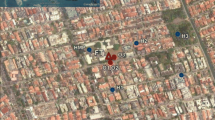Abstract
The role of surface geographical characteristics (e.g., albedo, thermal admittance, Bowen ratio, roughness) in the partitioning of energy at the complex and heterogeneous surface of several urban and rural land-use types has been evaluated through an application of Lettau's climatonomy theory. In contrast to the more conventional approach that first specifies all appropriate surface descriptors and then uses them to define climatic features, this application of climatonomy permits the determination of select surface descriptors on the basis of the observed diurnal response of surface temperature to the observed forcing function of available solar energy. Analyses were conducted for a variety of land-use types: urban residential, urban commercial, suburban, and rural farmlands and woods.
The solar forcing function and primary response function (i.e., effective surface temperature) were measured from repetitive diurnal aircraft flights over the greater St. Louis area during clear skies in August 1972. An estimate of surface roughness and subsequent parameterization of the atmospheric sensible heat flux were required for the analyses over nine selected sites. Photosynthetic and anthropogenic fluxes were not considered explicitly. The derived effective thermal admittance (square root of product of heat capacity and thermal conductivity) ranged from a minimum near 20 mly s−1/2 K−1 for urban and suburban sites to about 85 for wooded sections. The derived inverse Bowen ratio (ratio of latent to sensible heat fluxes) ranged from about 0.22 in the urban area to 2.9 for farmland.
Similar content being viewed by others
References
Changnon, S.: 1972, 1972 Operational Report for METROMEX, Illinois State Water Survey, Urbana, Ill., U.S.A.
Geiger, R.: 1965, The Climate Near the Ground, 4th Ed., Harvard University Press, Cambridge, Mass., U.S.A.
Kung, E.: 1963, ‘Climatology of Aerodynamic Roughness Parameter and Energy Dissipation in the Planetary Boundary Layer over the Northern Hemisphere’, Section 2 of Studies of the Effects of Variations in Boundary Conditions on the Atmospheric Boundary Layer, Dept. of Meteorology, University of Wisconsin, Annual Report, Contract DA-36–039-AUC-00878, USAERDA, Ft. Huachuca, Ariz., U.S.A.
Lettau, H.: 1976, Climatonomy of Arid Regions with Areas Under Irrigation, unpublished manuscript. Dept. of Meteorology, University of Wisconsin, Madison, U.S.A.
Lettau, H. H. and Lettau, K.: 1972, Exploring the World's Driest Climate: Scientific Results of Wisconsin Field Studies during July 1964 in the Peruvian Desert (Pampa de la Toya), University of Wisconsin Press, Madison, Wisc., U.S.A.
Panofsky, H. and Brier, G. N.: 1965, Some Applications of Statistics to Meteorology, Mineral Industries Continuing Education, Pennsylvania State College, University Park, Penn., U.S.A.
Van Wijk, W. R. (ed.): 1963, Physics of Plant Environment, North-Holland Publishing Company, Amsterdam, The Netherlands.
Author information
Authors and Affiliations
Additional information
Research sponsored by the Environmental Protection Agency under Contract No. 68-02-1015.
Rights and permissions
About this article
Cite this article
Dabberdt, W.F., Davis, P.A. Determination of energetic characteristics of urban-rural surfaces in the greater St. Louis area. Boundary-Layer Meteorol 14, 105–121 (1978). https://doi.org/10.1007/BF00123992
Revised:
Issue Date:
DOI: https://doi.org/10.1007/BF00123992




